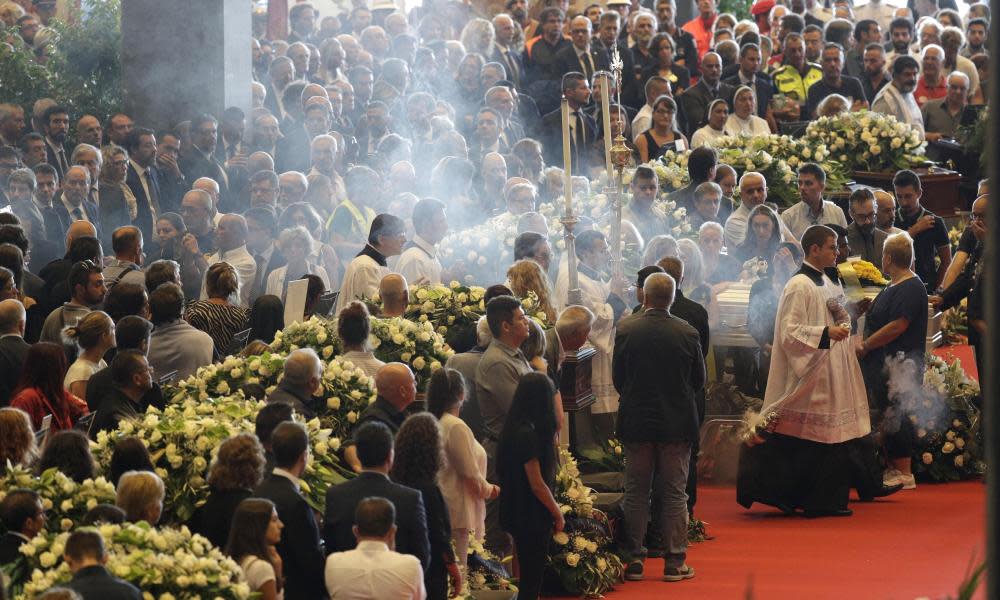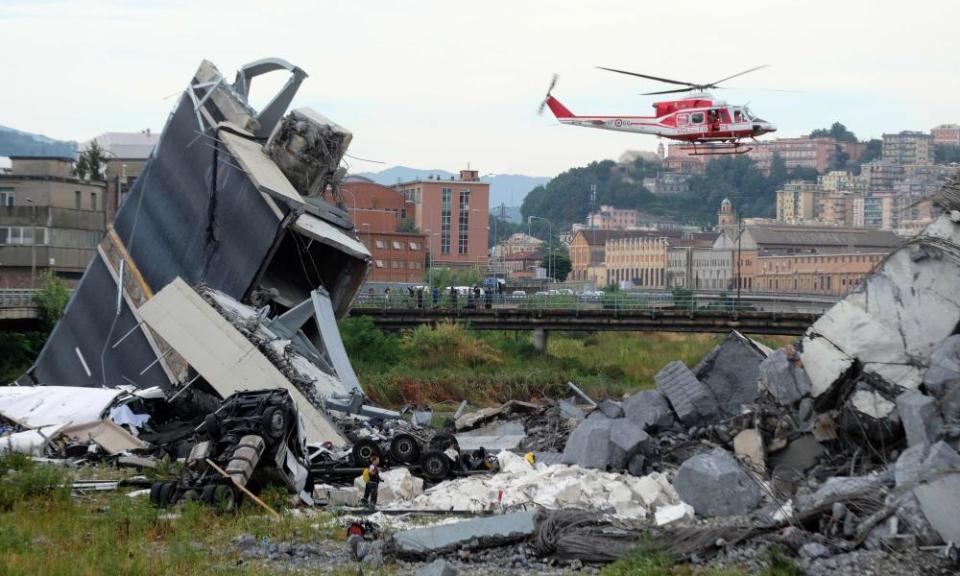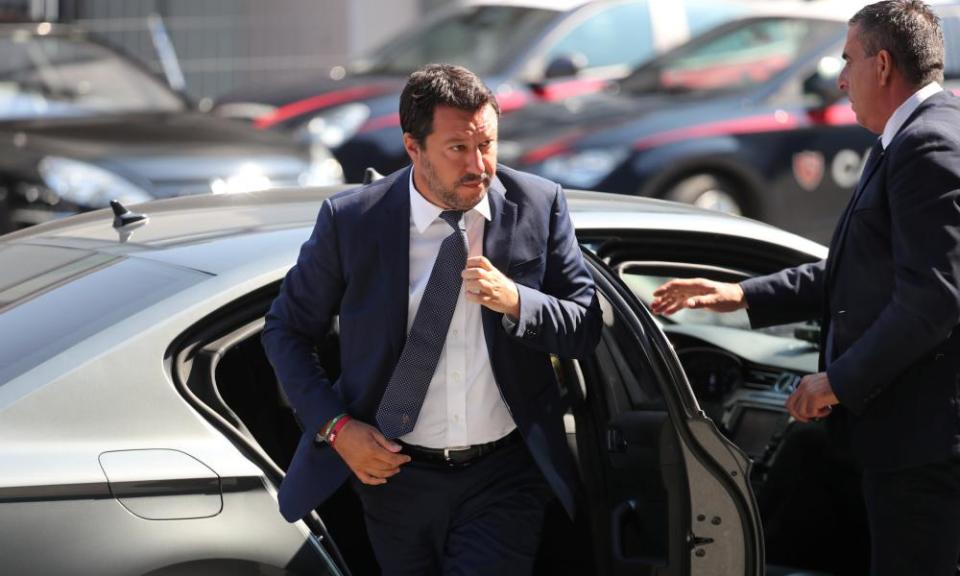Italy’s grief and anger grow as Genoa starts to bury its dead

The coffins, strewn with flowers and draped with the flags of different countries, were lined in a row as the mourners came in their thousands. The dead had come from far and wide – from Chile, the country of Juan Carlos Pastenes and his wife Nora Rivera; from France, home to a group of twentysomethings on their way to a music festival; from Albania, which two young Muslim men had left to pursue a better life in Italy; and from Genoa, the grief-stricken city of eight-year-old Samuele Robbiano and his parents. After the service, his small coffin was placed gingerly in a hearse accompanied by a large bunch of yellow flowers and two cuddly toy animals.
The port city held a state funeral on Saturday for 19 victims of the collapse last week of the landmark Morandi bridge. At least 42 people are now known to have died in one of the worst tragedies in modern Italian history, the death toll rising on Saturday after the bodies of a couple from Piedmont and their nine-year-old daughter were found in the wreckage. Rescuers were still working to find five more people who have been reported missing.
In his homily at the city’s exhibition centre, the archbishop of Genoa, Cardinal Angelo Bagnasco, said the viaduct’s collapse had “gashed the heart of Genoa”.
“The initial disbelief and then the growing dimension of the catastrophe, the general bewilderment, the tumult of emotions, the pressing ‘whys?’ have touched us yet again and in a brutal way showed the inexorable fragility of the human condition,” he said.
Applause rang out among the crowd of about 3,000 and many fought back tears as a prelate read out the first names of some 30 victims. The mourners also applauded firefighters, police and civil protection volunteers. And, when they saw Luigi Di Maio and Matteo Salvini, the respective leaders of the governing Five Star Movement-League coalition, they cheered.

But there was anger, too. A local man, Alessandro, held a placard that read: “In Italy, we prefer ribbon-cuttings to maintenance,” referring to the country’s dilapidated infrastructure. “These are mistakes that keep on repeating. And now, for the umpteenth time, angels have flown into heaven and paid for the mistakes of other human beings, severe mistakes,” he told the Associated Press.
Anger over a tragedy that many blame on the government was reflected in the decision of some families not to take part in the state funeral but hold private ceremonies. Four young men were buried at home in Torre del Greco, near Naples, on Friday. Other victims have also been buried in their hometowns.
Residents of Genoa are livid that concerns over the bridge’s safety were shrugged off and that the highways operator maintaining it, Autostrade, may have cut corners. Di Maio and Salvini have also blamed the privately owned firm for the tragedy, accusing it of poorly maintaining the bridge and threatening to revoke its contract while imposing a €150m (£134m) fine.
The company has denied cutting corners, saying that it has invested more than €1bn since 2012 on securing, maintaining and strengthening its highway network. Yesterday, at its first press conference since the disaster, it said it has set aside about €500m-worth of investment to help Genoa recover from the disaster. Autostrade’s chief executive, Giovanni Castellucci, expressed his condolences for the victims but, asked to give an unreserved apology for the collapse, he said: “Apologies and responsibilities are things that are connected. You apologise if you feel you are responsible …”
He would wait for investigators to determine responsibility for the collapse, he added.
People in Genoa are now reflecting on a tragedy which has not only exposed the fragility of Italy’s infrastructure, but also reminded them of the entrenched problems blighting its society, from corruption to the mafia, which a succession of governments has been powerless to do anything about.
“We’re in immense pain for those who died, and because we know there are others still under the rubble,” said Francesa Valle, a hotel owner. “We’re angry because they knew there were problems with the bridge for 30 years, but we are also worried about the future.”
At the scene, crushed vehicles protruded from beneath the rubble. A green truck that escaped the 45-metre (150ft) drop still stood eerily close to the edge of the broken bridge; a few metres behind were several other cars and two lorries. The vehicles are symbols of those who survived.
As regular users of the bridge contemplated their own good fortune, they also recalled previous tragedies that have afflicted Genoa, a city revered in the Middle Ages for its naval prowess but left vulnerable to flash floods and landslides due to poor urban planning over the last 50 years or so.
The deadliest was in 1970, when several streams and creeks, including Polcevera, which lies below the Morandi bridge, burst their banks and flooded parts of the city, killing 44.
“It happened here, I remember it as a child, and now this,” said Lucia De Maio, who lives in a nearby building.
But this latest tragedy could finally break the resilience of residents who, despite recognising the strategic and economic importance of a bridge that connected the northern Lombardy and Piedmont regions with the coastal Liguria and French border, have long been haunted by it.
“We have all used it – children, grandchildren – it could have happened to any of us,” said Luigi Miriello.
“But it has never been safe. Whenever crossing it I always tried to go over the part [that collapsed] as quickly as possible, there was always fear.”
Designed by engineer Riccardo Morandi, the bridge was considered a jewel of engineering when inaugurated in 1967. But local people never really warmed to it.
“It might look like [New York’s] Brooklyn Bridge, but it was always trembling,” said Franco, a volunteer with the civil protection service who declined to give his surname. He was monitoring the dry creek-bed below the bridge the night before it collapsed after a heavy storm alert was issued. “I’m no engineer, but I think [the bridge] was made badly from the beginning,” he said.

Engineers also had serious doubts. The Morandi bridge was plagued by structural problems since its construction, leading to expensive maintenance. On Tuesday the specialist engineering website Ingegneri.info published a piece that highlighted longstanding concerns over the bridge, calling it “a tragedy waiting to happen”.
Antonio Brencich, an engineering professor at Genoa University, said that materials used in the bridge were “destined to deteriorate quickly”. Residents also point the blame at the previous leftwing administration for stalling on Gronda di Genova, a motorways project that would have alleviated pressure on the Morandi bridge. Now expected to begin in 2019, it was hampered mostly because of a powerful opposition group that had the backing of the Five Star Movement, a party which has long railed against major infrastructure works.
The party has been accused of hypocrisy over a statement published on its website in 2013 that described worries about the bridge’s safety as a “fairytale”. The post , written by the opposition committee, went on to say that it could endure “another 100 years”. It was removed from the website within hours of the collapse.
“The statement from the committee only repeated what Autostrade said in an official document – that the bridge was safe and, with good maintenance costing €250,000 a year, could last another 100 years,” said Luca Pirondini, who heads the party in Genoa.
“We need to consider that M5S had no influence over the project – any decisions about it were made by the previous administrations. But going forward, we need a national plan for all works and maintenance – previously it was done badly.”
Those in Genoa are counting on a strong response from the new government to the tragedy – and much more.
“This tragedy is the final straw,” said Vincenzo Di Gaggia, a restaurant owner. “If things don’t change, there will be a revolution and Italy will be finished – Europe will also need to pay attention, because if Italy is finished, then so is Europe.”

 Yahoo News
Yahoo News 
